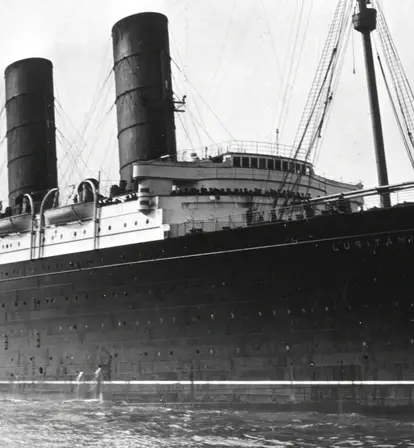The RMS Lusitania had recently departed New York when it was fatally torpedoed by a German U-boat. Unknown to the passengers on board, however, were 173 tons of weaponry bound for war.
Just three years following the sinking of the Titanic, there was another tragedy in the Atlantic: the 1915 sinking of the RMS Lusitania.
Of the 1,960 known passengers, 1,196 of them died after the British liner was torpedoed by a German U-boat in the midst of World War I.
The British ship had nearly the exact opposite route as its sunken predecessor and departed New York on May 1, 1915, to make the long journey to Liverpool — the Titanic left Southampton and was headed for New York. Besides civilians, the ship held a crew of over 500 — and some four million rounds of small-arms ammunition.
While the Titanic is largely believed to have been the result of human hubris and a lack of foresight, the sinking of the RMS Lusitania may have been the result of a political conspiracy. It even catalyzed — in part — America’s future involvement in the so-called Great War.

Wikimedia CommonsThe Lusitania at the end of her first leg the maiden voyage. New York City. September 1907.
Though it took nearly two years following her destruction, the United States did formally enter World War I, and it is often thought that the Lusitania incident, in conjunction with other factors, influenced this decision.
The RMS Lusitania
The RMS Lusitania and her sister ship, Mauretania, were the fastest passenger liners of their time. The high-speed Lusitania promised crowds first-class passage across the Atlantic in five days.
These two ships were also the largest liners from their launch in 1906 until they were surpassed by Olympic and, of course, the Titanic.
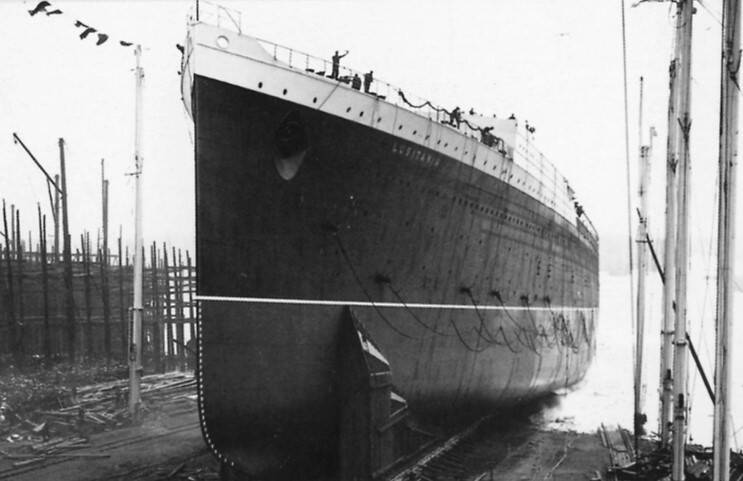
Wikimedia CommonsThe first launch of the RMS Lusitania. June 7, 1906.
The British government itself had sanctioned Lusitania‘s construction under the provision that should the circumstances require, she could be converted into an armed merchant cruiser.
When World War I broke out, it seemed Lusitania would be called for duty, but she was ultimately relieved of her wartime responsibilities.
Meanwhile, in an attempt to destroy the strong naval blockade the British had levied against them, the Germans waged unrestricted submarine warfare on British ships in the Atlantic. Commercial liners like the Lusitania were thus in great danger every time they went anchors up.
She nonetheless remained in commercial service. For a time her colors were painted grey in disguise and her fourth boiler was shut down. By 1915, however, Britain felt confident enough in launching the Lusitania with full colors and scheduled her for launch across the Atlantic on May 1.

Getty ImagesThe magnificent lounge of the Cunard steamship Lusitania circa 1910.
American Sentiment Before The Sinking
The sinking of the Lusitania would sweep the American public into a fervent anti-German sentiment, but before the tragedy, the United States saw little reason to involve itself in Europe’s bloody conflict. Tensions between Germany and the U.S. had escalated by 1915, however, as Germany’s attempts to quarantine the British Isles restricted America’s lucrative trade relationship with the U.K.

Getty ImagesNewspaper ad from the German Embassy in Washington warning Lusitania travelers.
Newspapers in New York published a warning on May 1, 1915 — right below an ad for the Lusitania — on behalf of the German Embassy in Washington, D.C, that Americans traveling on British or Allied ships in war zones should be aware of the danger in lurking German U-boats.
But the passengers were assured that the Lusitania‘s speeds would keep them safe and the captain was told to employ zig-zag maneuvers to avoid U-boats.
The Sinking Of The Lusitania
Captain William Thomas Turner took the helm of the Lusitania when the ship’s prior captain fell too ill to operate her. It was claimed that the prior captain was too anxious to direct a ship through a war zone.
On May 1, 1915, she launched off New York’s Pier 54 with a crew of 694 and 1,265 passengers, mostly British, Canadian, and American. The ship was burdened with an overbooked second class and a full first class.
At approximately 2:12 p.m. on May 7, 1915, a torpedo struck the ship’s starboard side. The 32,000-ton ship was irrevocably damaged. Some witnesses, including Captain Turner himself, would later say that two torpedoes were involved.

Wikimedia CommonsThe writing and reading room of for first class passengers of the RMS Lusitania.
The primary explosion led to a secondary eruption, likely due to the ship’s boilers blowing up from the initial blaze. It was presumably this subsequent detonation that resulted in the Lusitania’s rather expedient disappearance from the ocean’s surface.
It was difficult for the crew to launch lifeboats due to the angle of the ship’s sinking, and many boats splintered and capsized, taking dozens of passengers with them. The ship did not stay afloat for long and all passengers were forced to jump into the Atlantic’s freezing waters. As such, many froze to death or drowned.
It took a mere 18 minutes for the RMS Lusitania to start its descent to the ocean floor.
To make matters worse, a nearby steamship refused to come to the Lusitania‘s rescue as it feared that it too could be susceptible to a torpedo attack.
The Unknown 173-Ton Passenger
The public later discovered that the ocean liner was carrying supplies of war among its cargo — 173 tons of it, to be specific.
There were no mounted offenses aboard to protect it against enemy vessels, this was a cruise ship, to be sure, but here it was saddled with 173 tons of munitions bound for Britain presumably under the guise of a commercial voyage.
According to Steven and Emily Gittelman’s book, Alfred Gwynne Vanderbilt: The Unlikely Hero of the Lusitania, stowing weapons of war aboard commercial vessels had actually become common practice by 1915. In a stage of the war where wanton U-boat warfare could easily sink any and all transport ships supplying European allies with the tools they needed, alternatives had to be employed.
“Many ships such as the Cameronia had already been requisitioned by the Admiralty to become armed merchant cruisers or loaded heavily with ammunition,” the Gittelmans asserted.
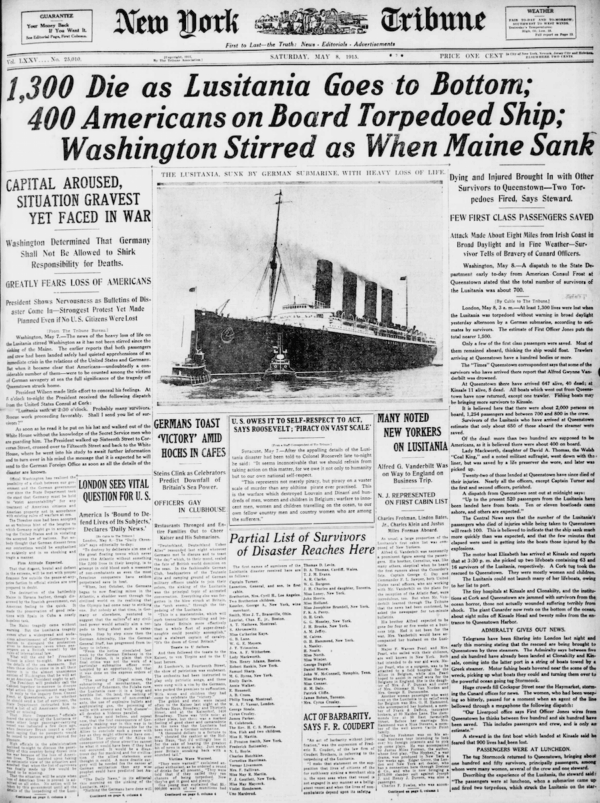
Chronicling America/Library of CongressThe New York Tribune‘s front page the day after the sinking of the Lusitania. May 8, 1915.
The Germans maintained that despite also carrying citizens, the Lusitania was carrying weapons of war, which made her an enemy vessel.
The United Kingdom subsequently saw a groundswell of anti-German sentiment. As the First Lord of the British Admiralty, Winston Churchill said that “the poor babies who perished in the ocean struck a blow at German power more deadly than could have been achieved by the sacrifice of 100,000 men.”
Moreover, American President Woodrow Wilson had already issued a diplomatic warning to Germany that if an American vessel or the lives of American citizens’ was lost without just cause, the United States would “hold Germany to ‘strict’ accountability.”
In September of that year, Germany formally apologized for the sinking and vowed to curb its unregulated U-boat warfare activity. For the time being, President Wilson was satisfied enough with this apology as not to declare war on Germany.
This didn’t last long. In 1917, the infamous Zimmerman telegram ushered the Americans into the Great War.
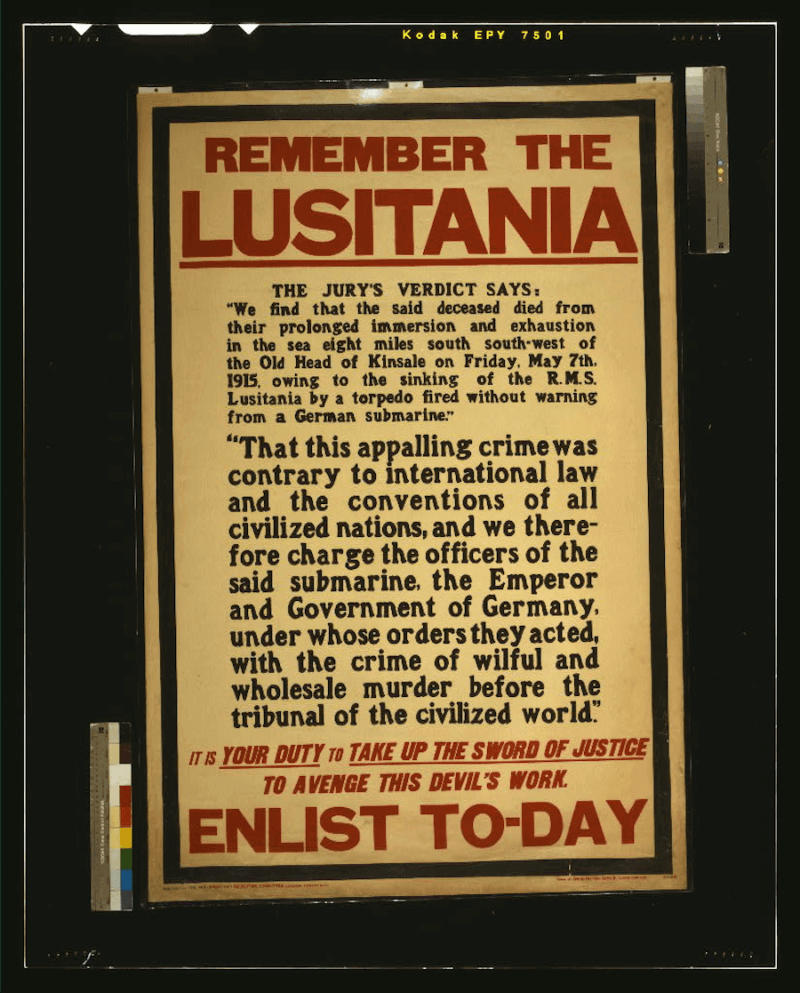
Library of CongressThe sinking of the Lusitania ushered in a dramatic rise in anti-German sentiment among both British and American citizenry.
An Impetus For War
British intelligence intercepted a telegram from German Foreign Minister Arthur Zimmerman to the German Minister of Mexico, Henrich von Eckhardt, which revealed that Germany was prepared to return to its previous model of wanton submarine warfare.
All ships in the official war zone would be sunk, regardless of their civilian capacities, the telegram read. The telegram also revealed that Germany was considering an alliance with Mexico if the U.S. sided with the European Allies.
This telegram, in combination with the loss of 120 American passengers aboard the Lusitania, justified to the Americans joining the war.
Meanwhile, the ship’s captain was accused of negligence and blamed for her destruction.
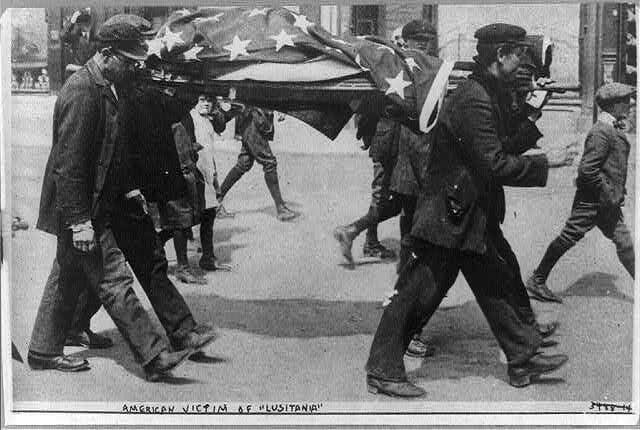
Library of CongressOne of the 120 American victims of the sinking of the Lusitania being carried away on a stretcher. 1915.
It was alleged that he was given specific instructions regarding safety maneuvers which he failed to follow. First Sea Lord Fisher asserted that “it’s a certainty that Captain Turner is not a fool but a knave. I hope that Turner will be arrested immediately after the enquiry whatever the verdict.”
It was concluded that Turner had ignored every safety precaution of which he had been informed and was thus the cause for the ship’s demise.
Caught In An Espionage Operation
According to Erik Larson, author of Dead Wake: The Last Crossing of the Lusitania, the blame does not solely rest on the ship’s captain, and rather, on a covert British mission.
In the Milton Keynes complex within Bletchley Park, where Alan Turing hacked the Nazi Enigma machine decades later, Brits deciphered German codebooks to mount anti-submarine espionage missions in a so-called “Room 40.”
Larson’s research has led him to believe that the British intelligence unit in Room 40 orchestrated a cover-up for the ship’s sinking by blaming it on the Lusitania’s captain in order to preserve its espionage program.
“Room 40 was this super-secret organization founded by the Admiralty to take advantage of the miraculous recovery of three German codebooks,” Larson explained. “Using those codebooks, they successfully intercepted and read German naval communications.”
Additionally, a British detective named William Pierpoint was assigned to board the Lusitania covertly to scope for potential German agents in hiding. He did apprehend three such agents the day the ship launched.
The question then becomes whether or not the British were aware of Germany’s attack on the ocean liner before it happened — and if so, did they then allow it to happen. But had they interfered, then they ran the risk of exposing their covert mission to the Germans.
Perhaps they too thought that in allowing the Germans to attack a commercial liner, then potential allies like the Americans would have a reason to join in their war effort.
One thing is for certain, however: the British blamed the Lusitania’s captain as soon as they possibly could which, in and of itself, warrants some suspicion.
“It’s not exactly clear why the Admiralty went after Turner,” said Larson. “But what is very clear from the record is that the Admiralty went after him immediately, within 24 hours. Turner was going to be made the scapegoat, which is odd because the publicity value of laying the blame on Germany would have been enormous.”
When asked whether or not Larson believed that this meant there was a British cover-up in place during the immediate aftermath of the ship’s tragic sinking, he didn’t dismiss the notion.
“Cover-up is a very contemporary term,” he said. “But one of Churchill’s top priorities, when he was in the Admiralty, was to keep Room 40 a secret. Even to the point, as one of its members said, of not passing along actionable information that could have saved lives.”
Larson even referenced a prestigious naval historian who wrote a book about the top-secret Room 40 department. The man, long dead, was interviewed and left behind a transcript in the Imperial War Museum in London which essentially confirmed Larson’s suspicions.
“I’ve thought and thought about this and there’s no other way to think about it except to imagine some sort of conspiracy,” the transcript read.
Survivor Accounts From The Lusitania
“She was presumed dead and was left among the pile of other dead bodies,” Colleen Watters reported to the BBC about her grandmother, Nettie Moore’s, experience on the Lusitania. “Fortunately, her brother John noticed her eyelid flutter and eventually they were able to resuscitate her.”
Nettie Moore’s survival the attack on the Lusitania wasn’t a singular occurrence. Though 1,196 people died — including 94 children — a combination of luck and human aid saved some 767.
“My grandmother, Nettie Moore, grew up in Ballylesson, County Down, and her childhood sweetheart was Walter Mitchell, who was the son of the rector at the local Holy Trinity Church in Drumbo,” Watters explained.
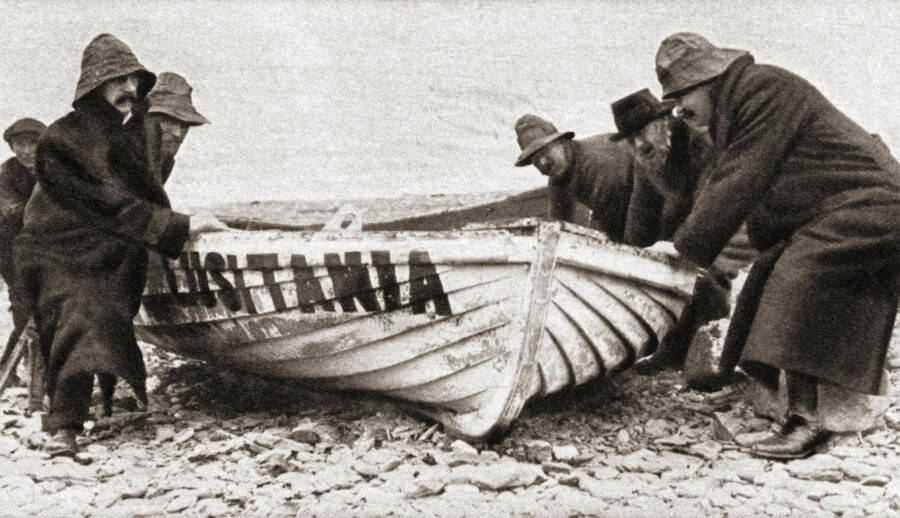
Universal History Archive/Universal Images Group via Getty Images)One of the lifeboats from the RMS Lusitania is hauled onto the beach on the coast of Ireland. May 1915.
When Mitchell was offered a position in Newark, New Jersey in 1912, he married Moore and the couple had a child named Walter in 1914. In order to get to New Jersey, the family decided to book a voyage on the luxurious ocean liner and set proverbial sail. Mitchell’s brother John tagged along.
“My grandmother always emphasized how happy they were on the boat,” Watters recalled. “They had just finished lunch when Walter and Nettie went down to the cabin to see the baby who was being looked after while John joined his friends playing cards.”
At that exact moment, the torpedo hit. Though the family managed to secure a lifeboat, the elements were too harsh to survive.
“Walter was holding his son but the baby died quite soon of exposure,” Watters said. “They were trying to hold onto an upturned lifeboat. Walter eventually said ‘I can’t hold on any longer’ and slipped away.”
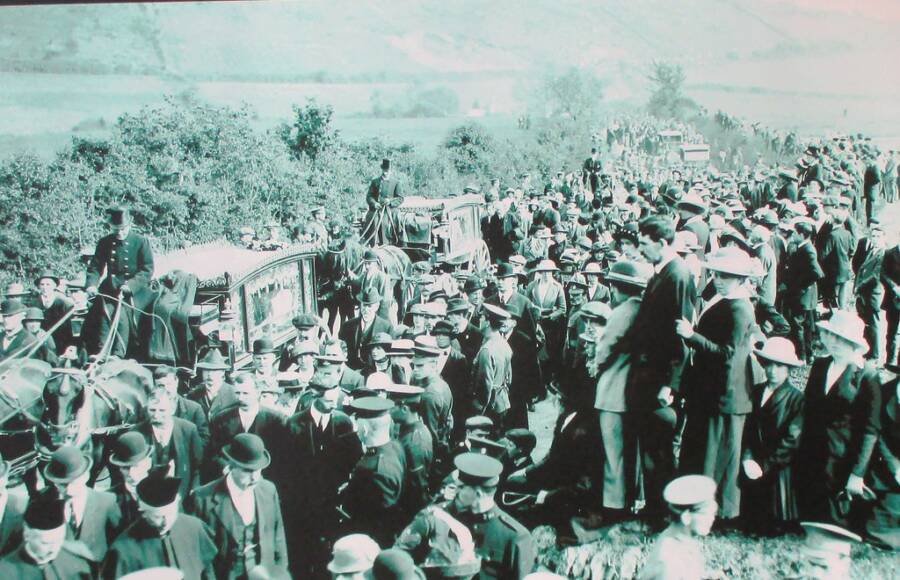
Facebook/Cobh and Cork Harbour CentenariesMourners following the sinking of the Lusitania gather in Cobh, Ireland.
“Their bodies were taken out of the water. My grandmother said she remembered being dragged by her feet, and her head bouncing on the deck of the ship. She was taken for dead and she was left with the dead bodies on the quayside.”
John, meanwhile, was fished out of the ocean by a local tugboat and brought to Cobh in County Cork, Ireland. He observed the dead being dragged out of the water — and saw both his brother and sister-in-law’s bodies. It was too late for Mitchell, but John managed to resuscitate Moore.
Moore was lucky. 885 deceased passengers were never found and of 289 bodies recovered from the sea, 65 were never identified.
“I have been told that Nettie was in a shoe shop in Cork, and John was buying her shoes so they could come home,” said Watters. “There she met some sailors who said they had found the body of a beautiful baby and she begged them to tell her where was the baby, what did they do with it, as she was sure it was Walter. But despite the best efforts, they weren’t able to locate the body.”

Topical Press Agency/Getty ImagesA funeral service for the victims was held in Cobh, County Cork, Ireland.
Moore, like countless other survivors of the RMS Lusitania, went through an unspeakably difficult time after the catastrophe. She couldn’t sleep and feared she would soon lose her mind. The loss of her baby only compounded her psychological troubles.
Only when a doctor overseeing her progress told her that she had to find hard work in order to find renewed purpose did she begin to get better. Moore became a nurse and trained as a midwife in the Rotunda hospital in Dublin. She spent the rest of her life helping deliver babies.
Ultimately, that is about as positive an outcome as any when it comes to those who lived through the Lusitania disaster. Most passengers died by drowning in the ocean or succumbing to the temperatures. Those who lived lost friends or relatives.
Tragically, the ship’s sinking only led to more casualties and deaths — as World War I had just gained a new participant from the U.S.
After learning about the sinking of the RMS Lusitania, have a look at these 33 rare Titanic photos from before and after its sinking. Then, check out the worst disaster in American maritime history, the explosion and sinking of the Sultana.
